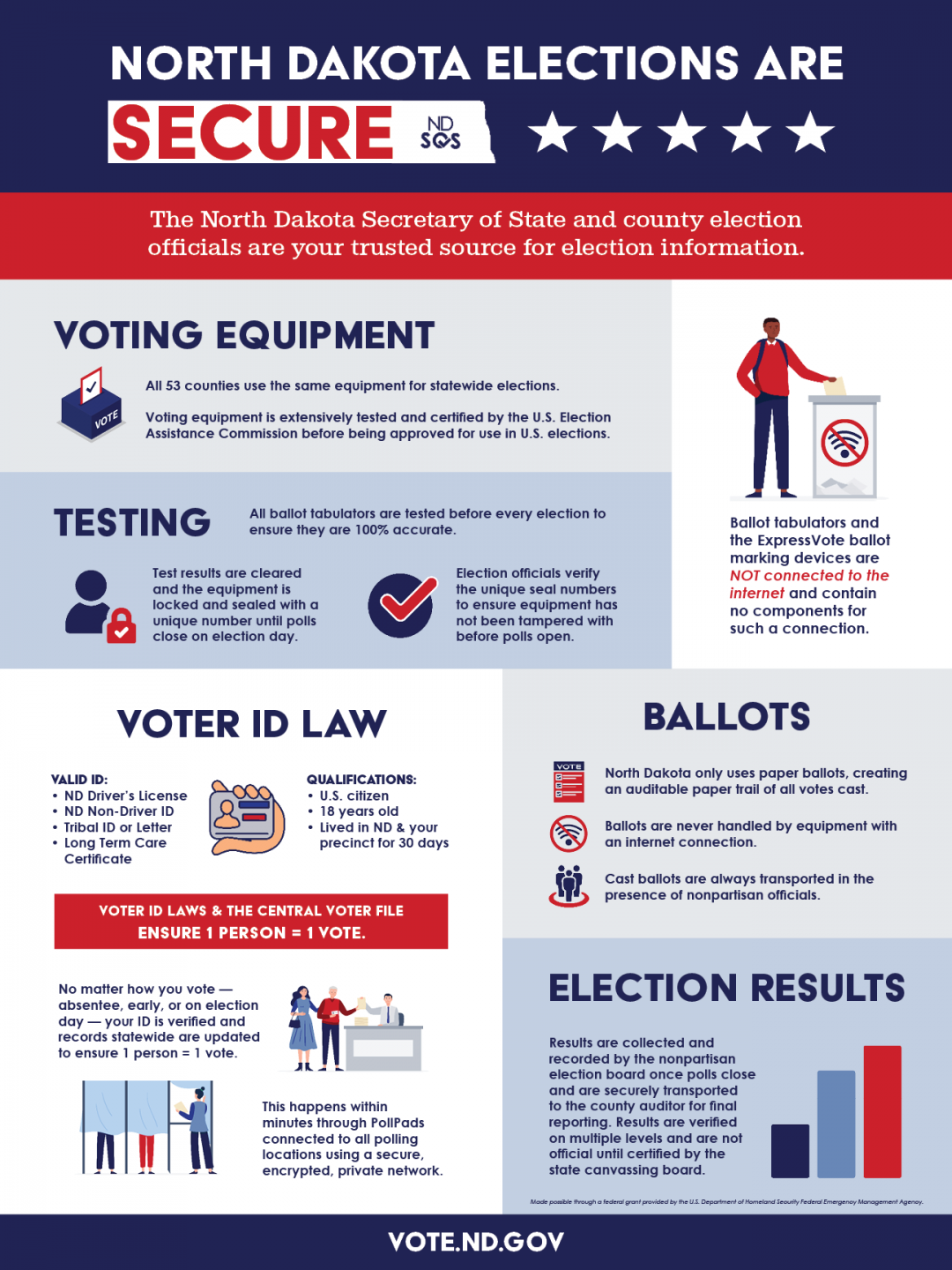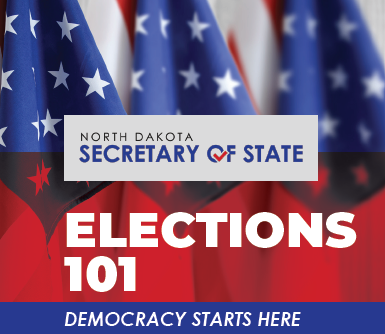
You & Election Security
The trusted source of information on elections is your local election official or the North Dakota Secretary of State. Opinions on election processes can be incorrect and misleading, and misinformation spreads easily. Be a smart consumer and sharer of information – you are the last line of defense in election security.
Did You Know?
Every County Has an Election Official
North Dakota statewide elections are a partnership between the Office of the Secretary of State and 53 county auditors throughout the state. This partnership promotes and supports secure, accurate, fair, and open elections for the citizens of North Dakota. Local jurisdictions, such as cities and school districts, may conduct their election with the statewide Primary election or may run the election themselves.
North Dakota Has Robust Voter Verification
One Person = One Vote
North Dakota’s Central Voter File ensures one person = one vote. Even if you mail an absentee ballot and show up at the polls to cast your vote, your voter record will show if you have officially cast your ballot. Whichever ballot is received first will result in your voter record being updated and not allow you to vote again in that election.
Only United States Citizens are Allowed to Vote
North Dakota elections are for American citizens only. Identification requirements ensure only U.S. citizens, who are qualified North Dakota electors, can vote in North Dakota.
North Dakota Requires Voter ID
North Dakota is the only state without voter registration, as our voter ID law requires a valid form of ID to vote whether you are voting by mail or in person (NDCC § 16.1-01-04.1). Voter ID helps prevent voter fraud by ensuring that eligible voters must verify their identity and meet qualifications prior to casting a ballot. Voter ID has been in place in North Dakota for over two decades.
North Dakota’s Voter Verification is Stronger than the National Voter Registration Act
North Dakota is a leader in election integrity efforts across the nation and has been proactive in safeguarding elections while ensuring only qualified North Dakotans are able to vote. North Dakota’s proactive stance is unique in that it does not require voter registration, exempting us from the National Voter Registration Act (NVRA). Our robust Voter ID laws allow for better integrity measures to protect North Dakota voter information. View a quick comparison between North Dakota’s voter verification processes and the NVRA, or more detailed information about how North Dakota stacks up against NVRA requirements.
Only Paper Ballots Are Used
North Dakota Only Uses Paper Ballots
North Dakota only uses paper ballots for voting. All votes cast and counted are on paper ballots. Paper ballots create an auditable paper record of all voting.
Electronic Ballot Marking Devices Use Paper Ballots
The ExpressVote accessible ballot marking device is an electronic display that allows a voter to electronically select their voting choices and then produces a paper ballot. The voter can review all their selections on the ballot printed by the ExpressVote. It is this paper ballot that the voter places into the tabulator to be counted. State law requires all votes cast in North Dakota be by paper ballot.
There is a Ballot Chain of Custody & Disposal
North Dakota has strong chain of custody procedures when handling voted ballots. Cast ballots are transported in the presence of nonpartisan officials. County recorders are the official keepers of the ballots after an election. Following the county canvass and applicable recounts, ballots are required to be sealed and stored until destroyed. State law and federal law requires that ballots are kept for 22 months following an election (NDCC 16.1-15-13).
Absentee Voting is By Request
You are Never Mailed a Ballot Without Requesting One
- Vote by mail counties mail voting age residents absentee ballot applications. You must fill out the application and provide identifying information which is verified by the county auditor before a ballot is sent to you. North Dakota has over 30 counties who are vote by mail and all have at least one polling location open on Election Day.
- In all other counties, you must request an absentee ballot application from your county auditor or through the Office of the Secretary of State.
Absentee Ballots Must be Received By Close of Polls on Election Day
Absentee ballots must be received by the close of polls on Election Day, and can be returned by mail, county drop box, or in person to the county auditor. They will not be accepted at polling locations on Election Day. Absentee ballots received after Election Day are not counted.
Ballot Tabulators are Secure and Accurate
Ballot Tabulators are Not Connected to the Internet
Ballot Tabulators Are More Accurate than Hand Counting
Prior to technology enhancements, ballots were counted by hand. While it seems simple, hand counting ballots is the method most susceptible to fraud, prone to inaccuracies due to human error, and very slow. All North Dakota counties use tabulators to count ballots. Tabulators are not connected to the internet and are tested both before and after the election for accuracy.
Voting Equipment is Certified and Tested
Same Equipment is Used in All Counties
Voting Equipment Systems are Certified
North Dakota takes election security very seriously. There are several steps taken to ensure the accuracy of voting tabulation equipment, before, during, and after an election. Election equipment is considered part of the nation’s critical infrastructure. The tampering with or unauthorized access and/or use of North Dakota’s election equipment is a class C felony under NDCC § 16.1-06-25.
- All voting equipment used in North Dakota is certified by the federal Election Assistance Commission (EAC) and the North Dakota Secretary of State according to state law. EAC certification requires each voting system to be tested by an independent testing authority prior to federal certification.
- Election officials follow strict processes that require:
- Using multi-factor authentication and security for all logins.
- Programming all voting equipment according to state law.
- Testing equipment for 100% accuracy prior to and after each election.
- Conducting an election with bipartisan poll workers and observers.
- Verifying the total number of ballots cast matches the total number of voters.
- Maintaining a strict chain of custody for all ballots.
Equipment is Tested Before & After Election
North Dakota law requires that tabulating equipment be tested before and after the election, known as “logic and accuracy testing.” The purpose of the testing is to ensure the tabulating equipment is tabulating ballots properly. During the logic and accuracy testing, both proper and improper ballots are submitted through the tabulator to ensure the counting is accurate. This testing is also open to the general public to attend and observe. Representatives from political parties receive an invitation from the county to attend as well.
Third Party Review of Election Equipment
Election equipment is extensively tested under Federal Election Assistance Commission (EAC) standards by experts in election technology and processes. North Dakota’s election equipment is secure, and third-party testing in 2022 determined that it is exceptionally unlikely that the results of an election in North Dakota would be fraudulently influenced. In fact, because of the numerous safeguards North Dakota has in place to protect election integrity, it would take unprecedented collusion – mass cooperation of people operating in secrecy – for fraudulent influence to occur. Review the Voter Process Security Assessment audit report for more information.
Election Results are Verified on Multiple Levels
Election Results are Not Final Until Certified
Once polls close, unofficial election results are submitted to the North Dakota Secretary of State. Election results are unofficial until canvassed. Local canvassing boards, made up of election officials and qualified electors, meet 13 days after the election to account for every voted ballot to ensure all votes are included in official results. Canvassing boards:
- Review late-arriving absentee ballots
- Review set-aside ballots
- Tabulate any approved ballots
- Certify the results
Following the canvassing boards, the North Dakota Secretary of State certifies the election.
FACT: Qualified electors serve on many election related boards to ensure election processes are conducted with integrity.
Election Results Can Only be Changed by Contesting an Election
Ten or more North Dakota voters, or defeated candidates, may contest an election result. The voter must file an election contest with the district court. Election contests are handled with in the court system and the judge has wide discretion in how to address the contest. Those contesting the result must pay for the recount of the race unless certain requirements in law are met. Election contests do not apply to federal races.

Download printable PDF of "North Dakota Elections Are Secure" poster (letter size)
Information featured on the "North Dakota Elections Are Secure" poster can also be found in the Did You Know? section on this page.
Elections 101
Elections 101 is our initiative to provide education about voting processes in North Dakota and the security of our elections. Download the Elections 101 Info Sheet to learn about:
- Who runs our elections
- North Dakota election integrity safeguards
- Voting options
- Our state's voter ID laws
- Election equipment used statewide
Download this resource for more facts about North Dakota elections and processes.

